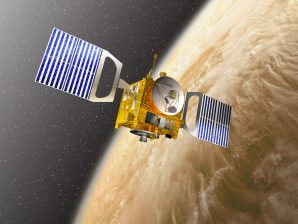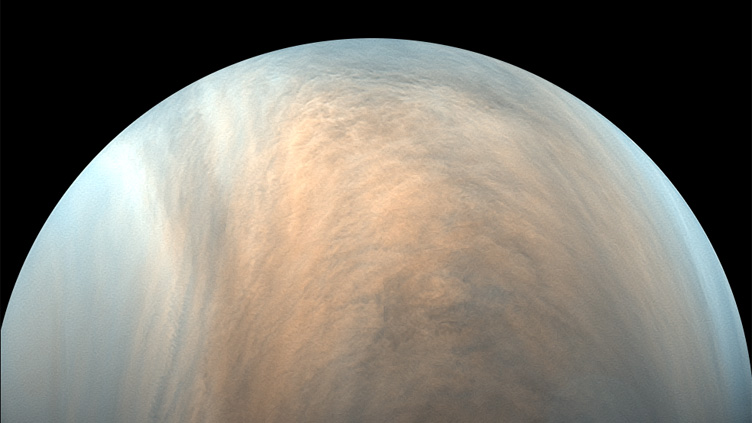The most precise version of the full-physics 3D model of the atmosphere of Venus gives insights into its highly unstable and largely unexplored outer layers, according to two new studies, each co-authored and led by researchers of the Instituto de Astrofísica e Ciências do Espaço (IA).
The air is rushing, faster than sound, 130 kilometres above the surface, blasting from the east, but is suddenly hampered at night fall, compressed into a shock. It could happen in the atmosphere of Venus, but is actually a days-long simulation running on supercomputers, in France, where it was initially developed, but also in Portugal, the United States and Canada.
The upgraded Venus General Circulation Model (VGCM), a 3D model fully packed with physical and dynamical processes, simulates the Venus atmosphere with the highest resolution ever, up to the altitude of 150 kilometers. It is now closely mimicking recent scientific observations, while also revealing details that might explain a few of the many unknowns of Earth’s false twin planet. These results are reported in a pair of papers1 published online in March in the journal Icarus, respectively co-authored and led by Gabriella Gilli, of the Instituto de Astrofísica e Ciências do Espaço (IA) and Faculdade de Ciências da Universidade de Lisboa (Ciências ULisboa).
“The nightside is so cold that it was named ‘cryosphere’ above 100 kilometres. The strong gradient of temperature and pressure between the day and the night produces the strong winds, faster than sound waves.”
Gabriella Gilli
The two studies focused on altitudes between 80 to 120 kilometers, a highly variable region of the Venus’ atmosphere sandwiched between the full force winds at the cloud deck and the thermosphere. “Some of my colleagues call these upper layers the ‘unknownsphere’, to highlight the lack of knowledge and measurements we have from this region,” says Gabriella Gilli, who has been trying to interpret this puzzling region by extending the VGCM with physical processes occurring at higher altitudes and validating the model with observations from the European Space Agency’s (ESA) Venus Express orbiter and from telescopes on Earth.

The first of the two studies now published “revealed details never simulated before and shows a highly variable nightside atmosphere, suggested by observations, but never described by other numerical simulations,” says co-author Gabriella Gilli. She led the second study, in which her team shows that the model is able to provide reliable estimates for temperatures and winds in regions where measurements are scarce.
In the absence of clouds at high altitudes, the abundances of molecules like carbon monoxide or oxygen allow scientists to track the dynamics of the atmosphere. Past observations of bright spots of infrared night glow2 specific to molecular oxygen and found at high latitudes puzzled the scientists. This improved version of the VGCM is the first numerical model to reproduce that.
Based on unexpected features, emerging in the simulations but not yet observed on Venus, Thomas Navarro (UCLA and McGill University) and his team offer the first explanation for those patterns found in the infrared night glow: a shock-like structure produced by a sharp decrease in the supersonic wind speed at dusk and dawn, and also a type of gravity atmospheric wave3 of planetary scale, named Kelvin wave.
Navarro, the other lead author and co-author of these studies, explains: “That airglow changes in a matter of a few hours because of the wind variability increased by the shock. And it reaches high latitudes due to the poleward wind circulations enhanced by the Kelvin wave.”
The data validation of the model, and the complementarity of the two studies, give scientists confidence to interpret those unexpected features as responsible for the observed variability of the Venusian nocturnal hemisphere. Day and night on Venus are in fact radically different because the planet rotates very slowly.
“One day on Venus is extremely long, about 117 Earth days, with implications on the distribution of the solar radiation,” explains Gilli. “The nightside is so cold that it was named ‘cryosphere’ above 100 kilometres. The strong gradient of temperature and pressure between the day and the night produces the strong winds, faster than sound waves, characteristic of the day-to-night circulation of those upper layers, moving from noon to the night side4.”

Venus rotates slowly in the opposite direction relative to Earth’s, completing a full turn in 243 days. Positive values for the wind speed indicate the air movement is from east to west (from midday to dusk on Venus), and negative values from west to east (from midday to dawn on Venus). The yellow line indicate where both fluxes converge, cancelling each other.
Credits: Gilli et al., 2021
The VGCM was first developed at the Institut Pierre-Simon Laplace (IPSL), in France. This upgraded version discriminates details at the equator between grid cells of only 200 by 400 kilometres, and smaller at other latitudes. It is crucial to interpret the observations and to reveal the physical mechanisms at stake on Venus. It may also give insights into the past or future of our home planet, but Venus is as well an analogue to anticipate the study of worlds outside the Solar System – slow rotating exoplanets with high surface pressure and a dense and cloudy atmosphere, in line with research at IA in this field.
The results now published in the journal Icarus demand further observations of the Venusian outer atmospheric shell: the upper mesosphere and the thermosphere. While we still have to wait about two decades for another space mission to our neighbour, telescopes on Earth can monitor the abundances of dynamical tracers (chemical compounds) and map winds and temperatures.
IA researchers and MSc students at Ciências ULisboa, Diogo Quirino and Vasco Silva, were also involved in these studies, fine-tuning the model parameters to better reproduce temperatures according to Venus Express data, and in the study of dynamical tracers extracted from the model in the same regions and times of the day as observed.
Notes
- The article “Venus’ upper atmosphere revealed by a GCM: I. Structure and variability of the circulation”, by T. Navarro, et al., was published online on 6th March, 2021, in the journal Icarus (DOI: https://doi.org/10.1016/j.icarus.2021.114400). The article “Venus upper atmosphere revealed by a GCM: II. Model validation with temperature and density measurements”, by G. Gilli, et al., was published online on 26th March, 2021, in the journal Icarus (DOI: https://doi.org/10.1016/j.icarus.2021.114432).
- An airglow (or nightglow, if produced during the night) is an emission of light by a planetary atmosphere. It can be produced by different photochemical processes leading to the formation of an excited atom or molecule. When these return to their normal energetic state, they release light, much like the fluorescence produced after certain substances have been exposed to light.
- Gravity waves (not to be mistaken for gravitational waves) are fluctuations in a fluid medium. They are caused by displacements of the medium from its stable position relative to the force of gravity, and propagate as the medium tries to restore its equilibrium. Sea waves, either caused by the wind or by maritime currents going over seabed reliefs in shallow waters, are examples of gravity waves.
- The day-to-night circulation is also named the Subsolar-Antisolar Circulation, when winds converge from the Subsolar point (right below the Sun, at noon on the equator) towards the Antisolar point (the further away from the Sun, at midnight on the equator).
Contacts
Gabriella Gilli
Science Communication Group
Sérgio Pereira; Ricardo Cardoso Reis; João Retrê (coordination, Lisbon); Filipe Pires (coordination, Porto)


